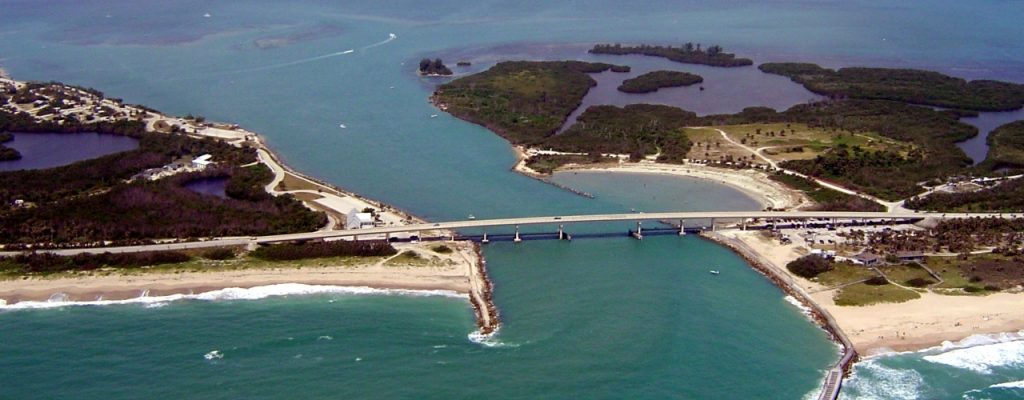by Lawrence Sarsoun
Years ago and new to Brevard county, we were camping at Sebastian Inlet State Park when it occurred to us that we were living in the famed “Indian River Grapefruit” area. Up north, we  enjoyed the fine oranges and grapefruits from this central part of the Florida coast, and now, here we were, living in the area, and you know how the light bulb sometimes comes on? Anyway, camping at Sebastian brought us face to face with the Indian River. We had seen the signs on the way down to the park, coming south on Florida route A1A, bringing to our attention, that we were on the Indian River Lagoon scenic route. Glancing at the map, and being kind of a geography buff (yes, they are few and far between), we went searching for the source of the river and of course, it’s mouth. Much to our chagrin, this “river” had neither a mouth nor a source.
enjoyed the fine oranges and grapefruits from this central part of the Florida coast, and now, here we were, living in the area, and you know how the light bulb sometimes comes on? Anyway, camping at Sebastian brought us face to face with the Indian River. We had seen the signs on the way down to the park, coming south on Florida route A1A, bringing to our attention, that we were on the Indian River Lagoon scenic route. Glancing at the map, and being kind of a geography buff (yes, they are few and far between), we went searching for the source of the river and of course, it’s mouth. Much to our chagrin, this “river” had neither a mouth nor a source.
Now in case you were asleep in geography class that day, just about all decent and law-abiding rivers have a source and a mouth. Take the Mississippi river, for instance. The Mississippi starts its long voyage down the mid-section of America at tiny little Lake Itasca, in Minnesota and ends up at New Orleans, where the mouth of the river opens into the Gulf of Mexico.
So here’s the Indian River, and it has no source and it has no mouth. Having neither, we are now beginning to question its claim to ‘river’ status. But, remember, the sign said there was a lagoon. O.K., so what’s a lagoon? Our Webster’s dictionary says it is an area of shallow water separated from the sea by low banks. We recollect pictures of South Pacific atolls, rings of land surrounding a body of water. Nope, the Indian (not a river) is not a lagoon either.
But wait, somewhere I remember reading about this body of water being an estuary. Yes, that’s it, it must be an estuary. Uh, what’s an estuary? Glad you asked. Mr. Webster says it’s that part of the mouth or lower course of a river in which the river’s current meets the sea’s tide. Well, if it isn’t a river, then you can’t have the sea’s tide meeting the mouth now, can you?
So we have the Indian (not a river),(not an estuary). The ranger tells us the water is brackish, meaning it is salty. My young nephew, on the camping trip with me, suggests that we rename this body of water the Indian Wet Water, which, while not exactly falling off the tip of the tongue, does seem to get to the factual bottom of the situation. More researching of pamphlets passed out by the rangers, as well as a trip through the very interesting fish museum at the park, and we find out that the inlets (think they said there were 7 of them) were created to open the inner body of water to access the sea. The cuts were made in the barrier islands, and bridges were built over the new waterways, thus allowing boat traffic to flow in and out from the sea to that inner body of water, while auto traffic made its way north and south on A1A.
Putting all this new-found knowledge together, the nephew and I sit down to do some fishing, and the thought comes to us…..Ah, the wonder of it all, this amazing Indian Wet Water. We are sitting on the side of the IWW, drowning worms in a timely fashion, thinking about the beauty of it all, and wondering if we should write a letter to the road department, suggesting they re-do the signs? Nah, let the world wallow in its ignorance. After all, we wouldn’t want to shatter the dreams of all those folks from up north who are eating those Indian River Grapefruits. Indian Wet Water Grapefruits just wouldn’t sound quite as glamorous, would it?

NOTE – You can find the Sebastian Inlet State Park on route A1A about 30 miles south of Melbourne, Florida. Yes, there is camping (but don’t take site 36, as that’s my favorite, and I might want to reserve it).You can reserve your site through Reserve America, but be warned that the park is very popular, and fills up months in advance. There’s lots to do there, fishing in the ocean or the ‘wet ‘water, surfing, a jetty that sticks out into the ocean, the beach, two museums, camping, a marina, guided boat trips. Go to the Florida State Parks website for more info at: www.floridastateparks.org
Mr. Sarsoun is the author of books like “America’s Monetary Mess”, all about the dangers of inflation, his auto-bio(he is 76 years old), “Route 41….and Other Stories”, and “Character Traits For Teens (and Adults who haven’t got it together yet)”. His books are available locally from Wren Services, 4750 Decatur Circle, Melbourne, Fl. 32934, at lsarsoun@yahoo.com or call 321-266-7219. – Copyright 2005
